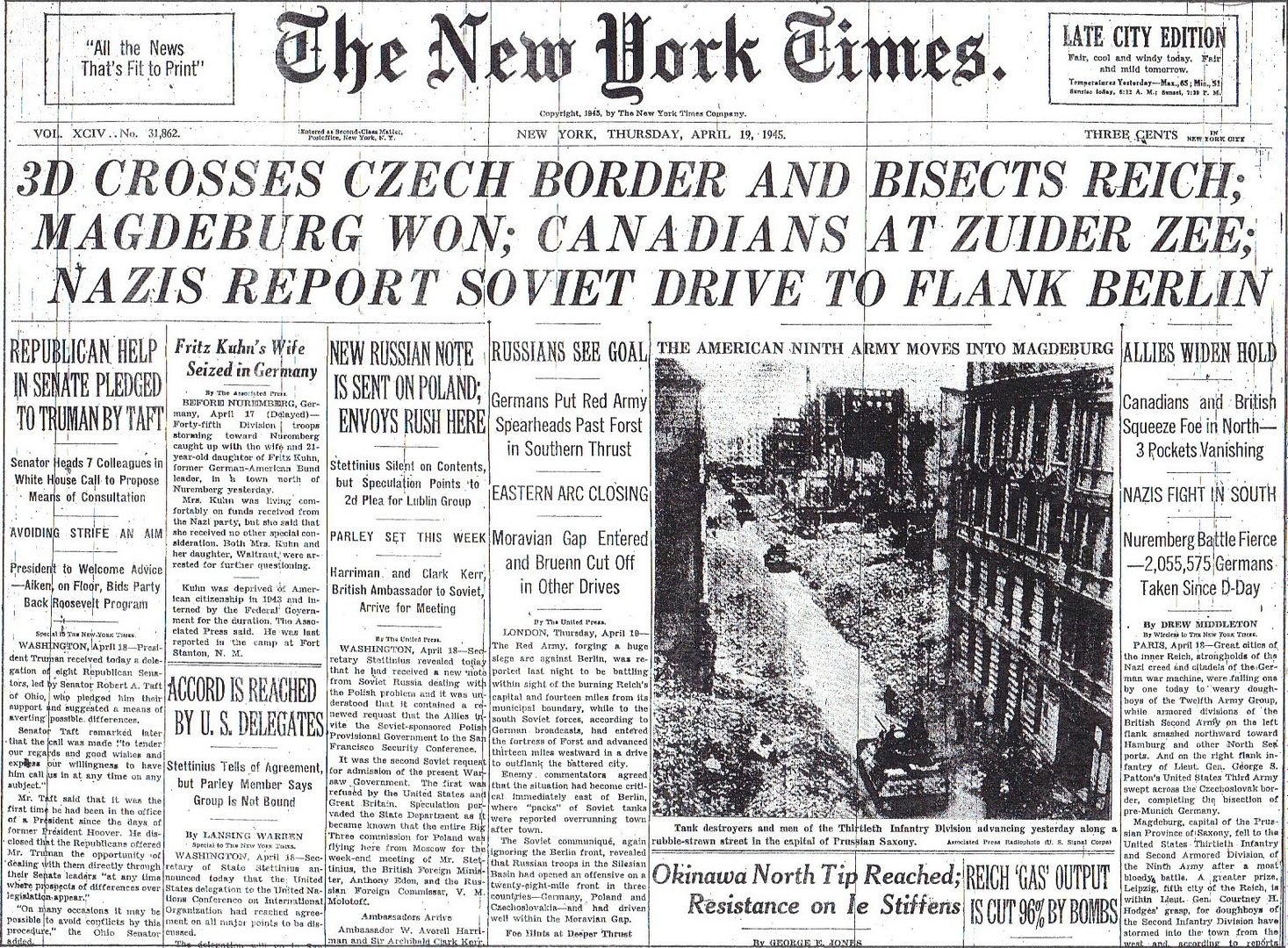
Posted on 04/19/2015 4:23:46 AM PDT by Homer_J_Simpson

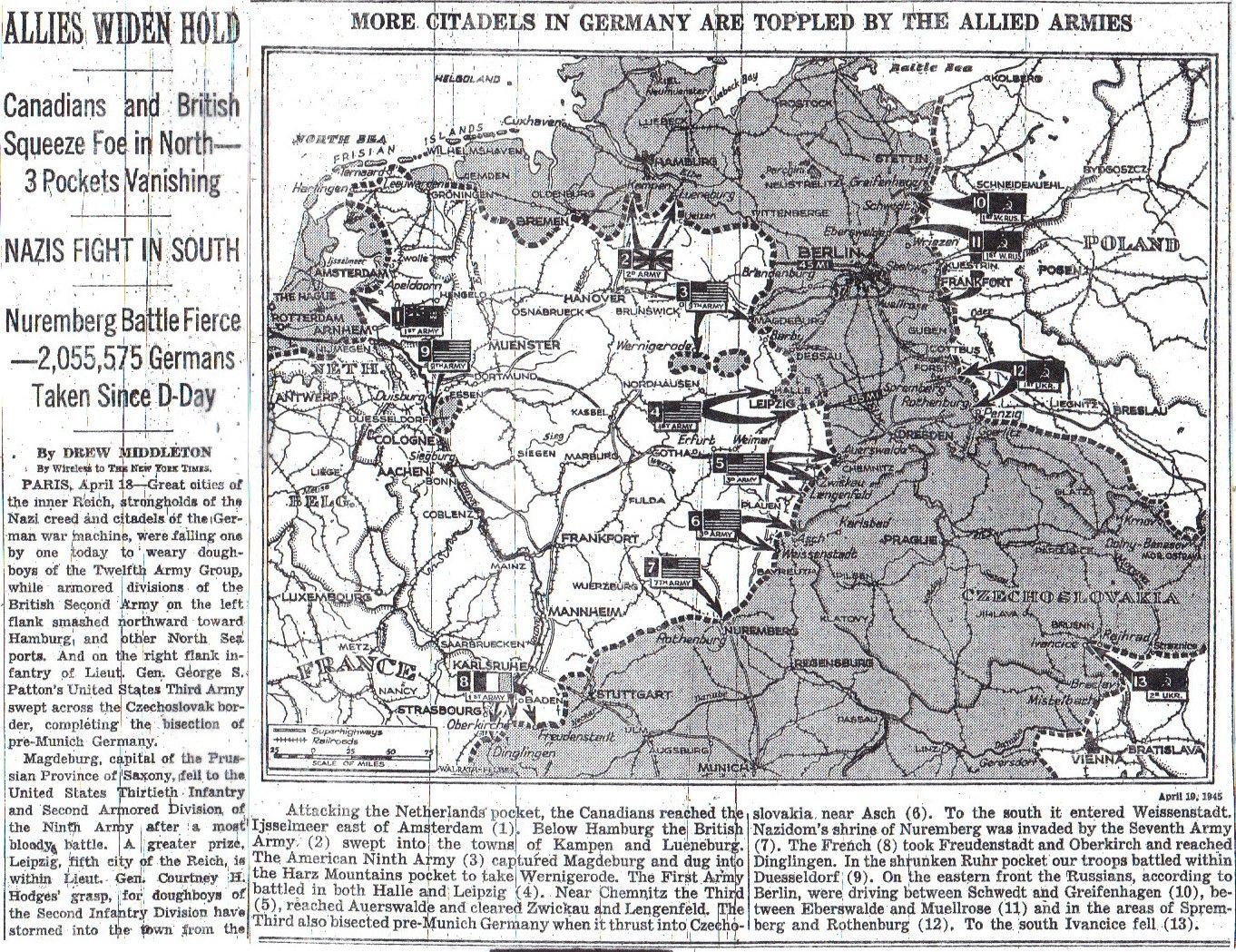
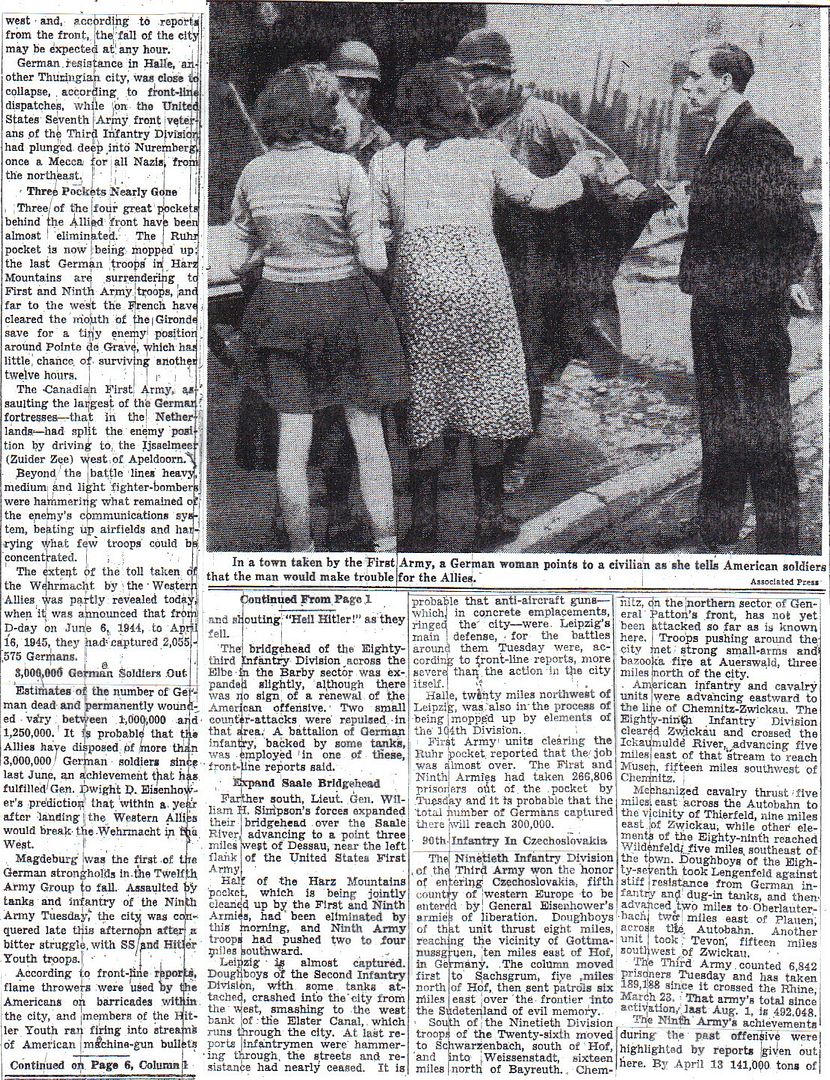
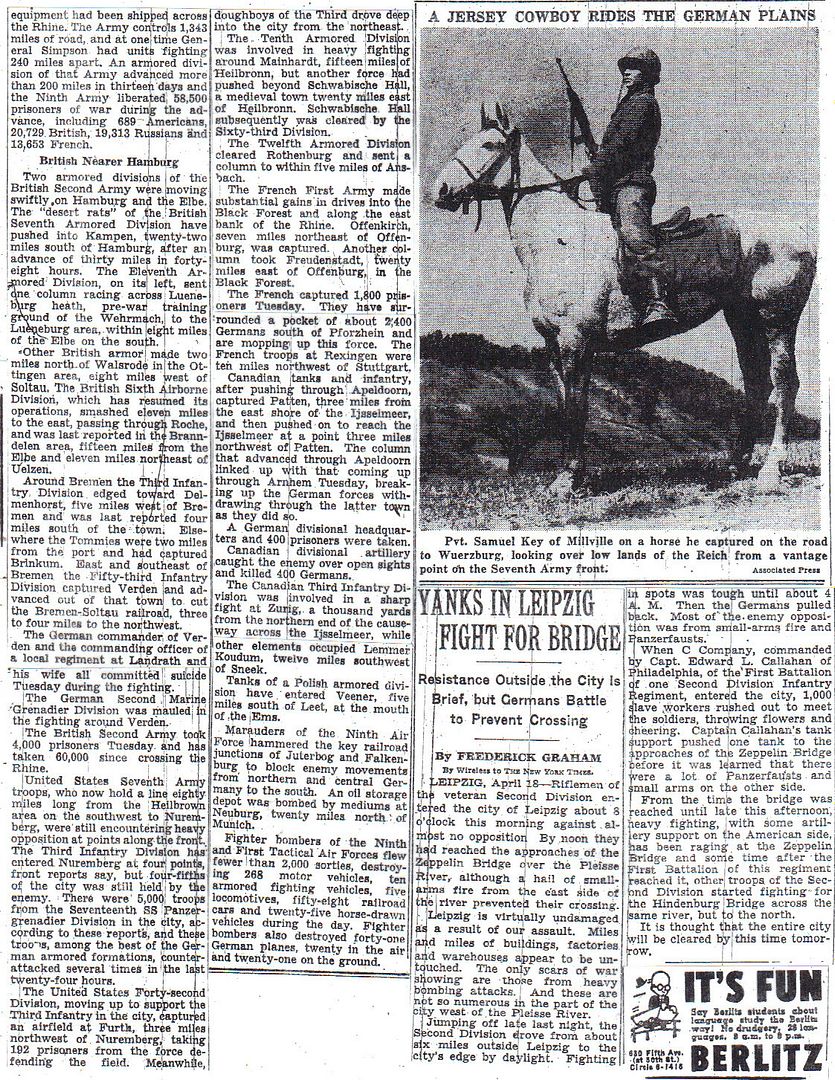

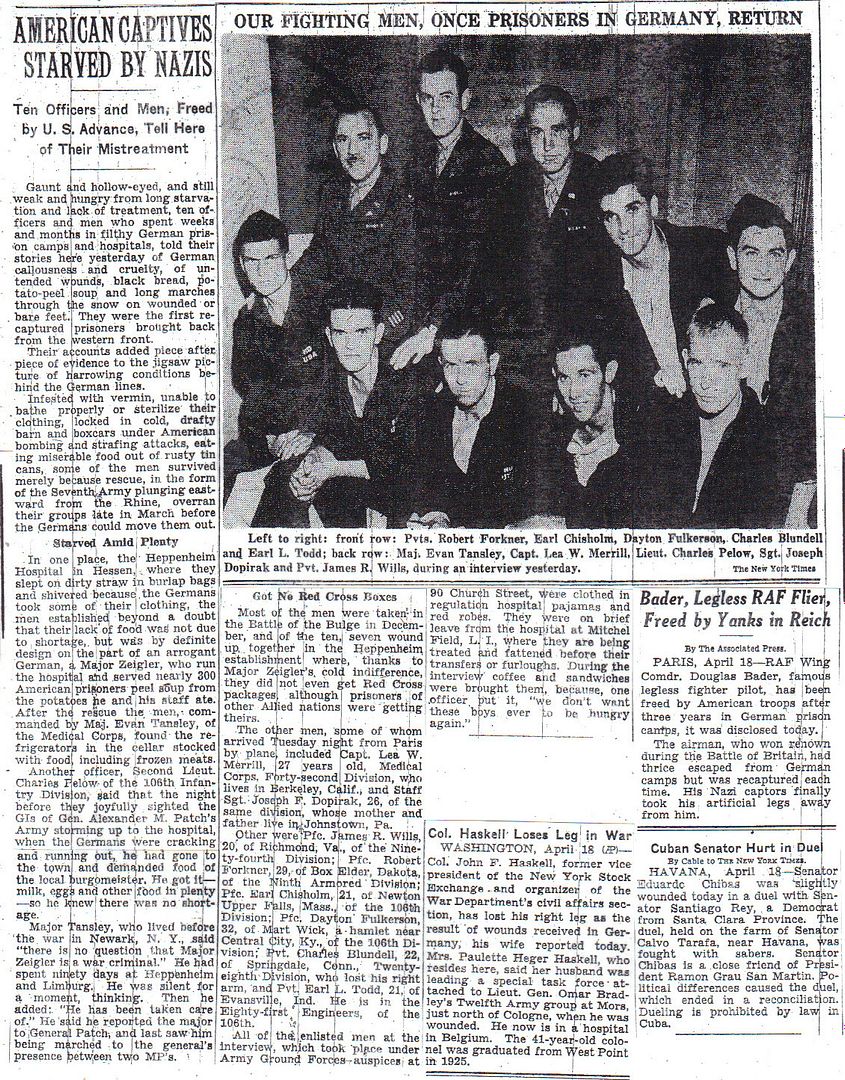
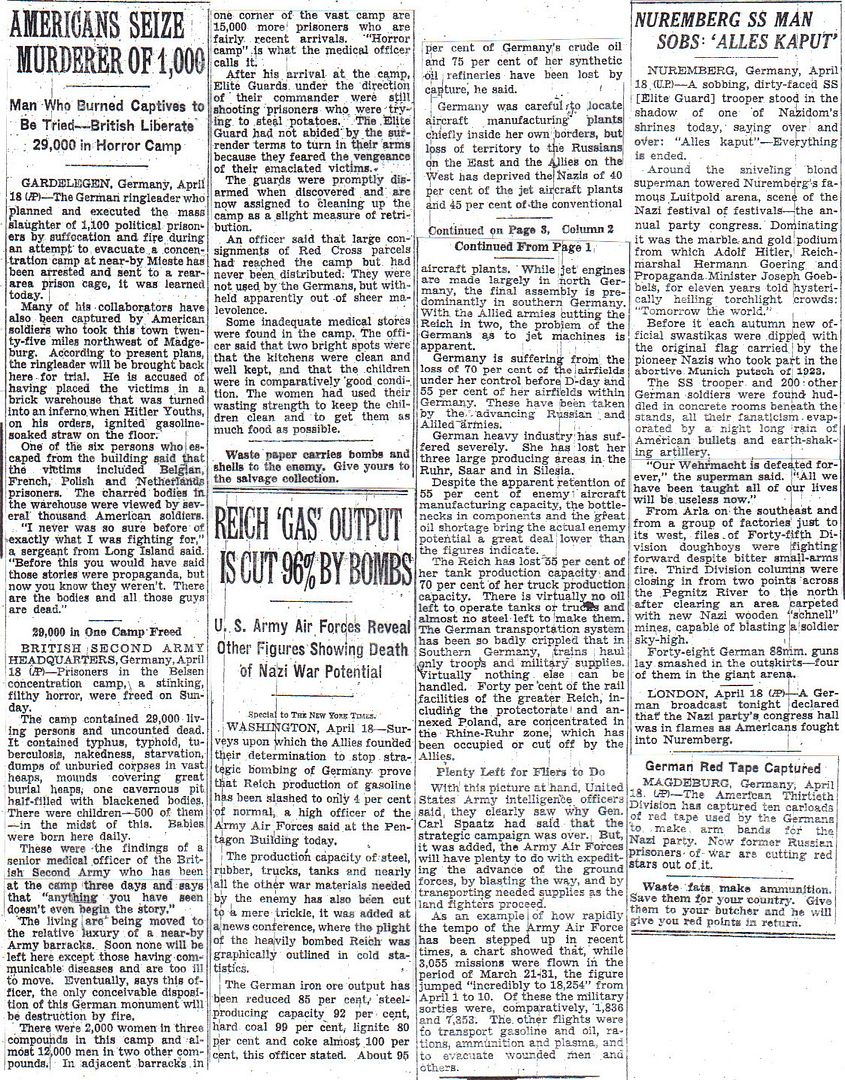



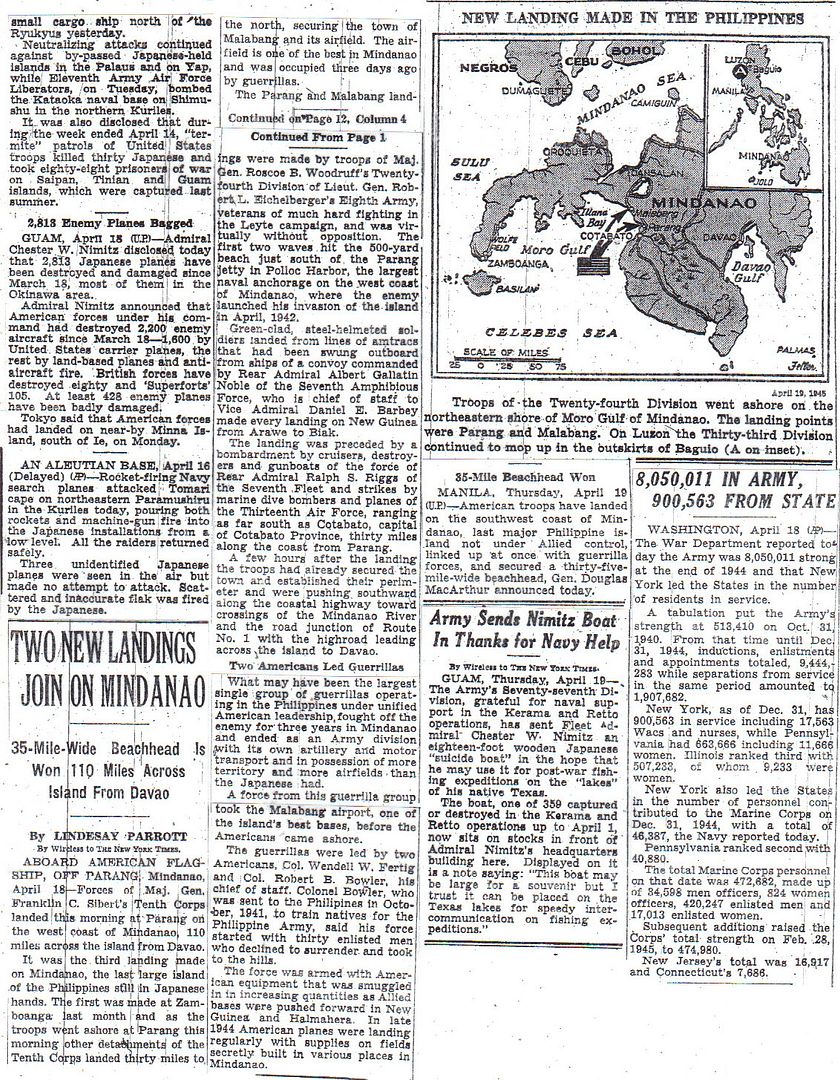

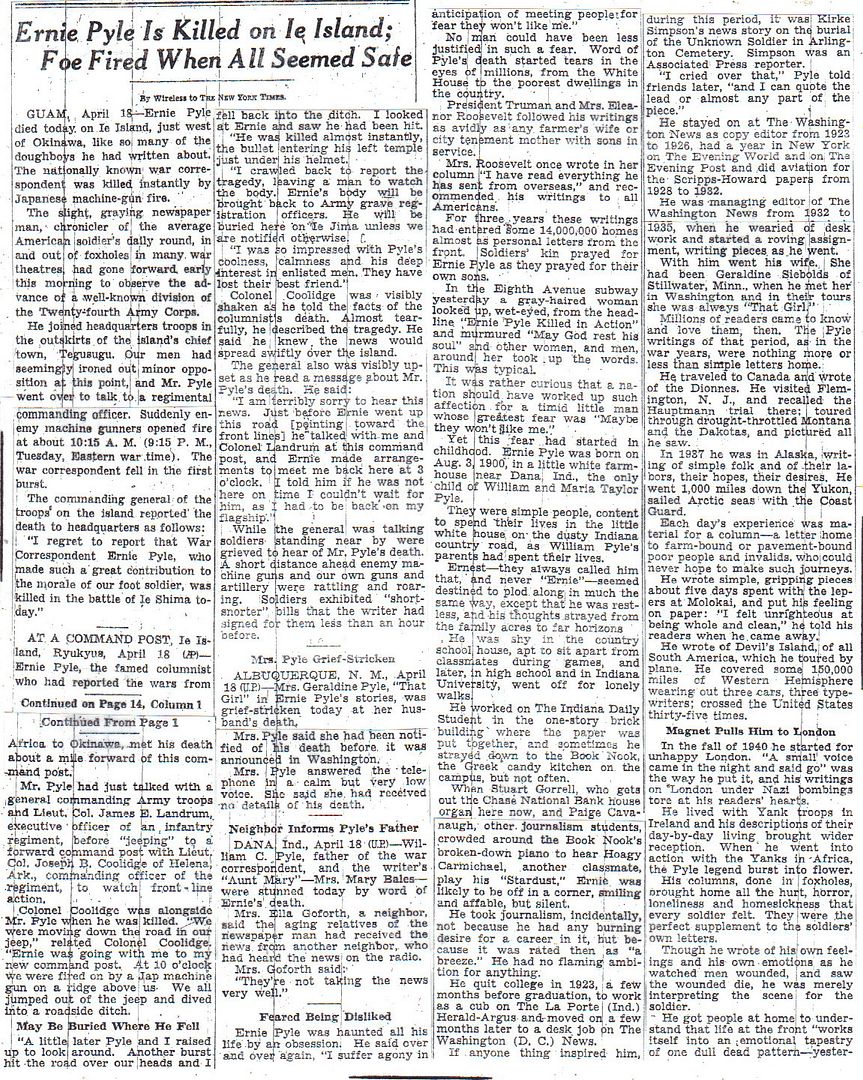
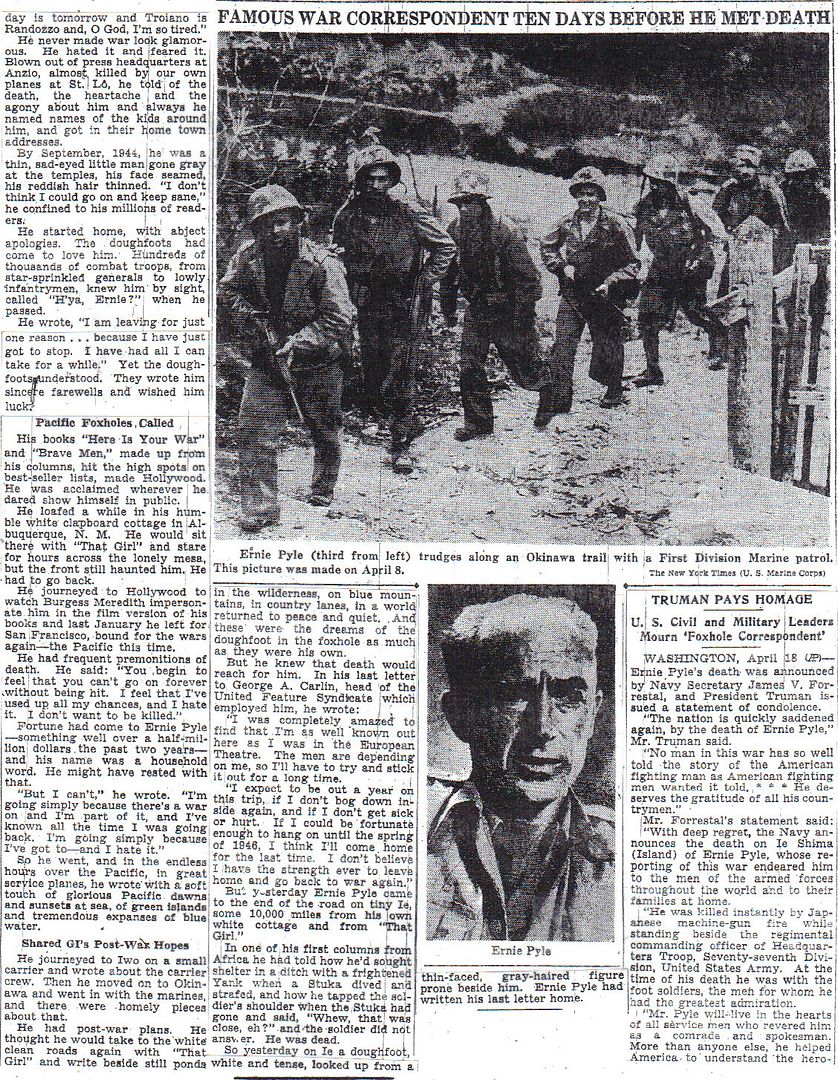

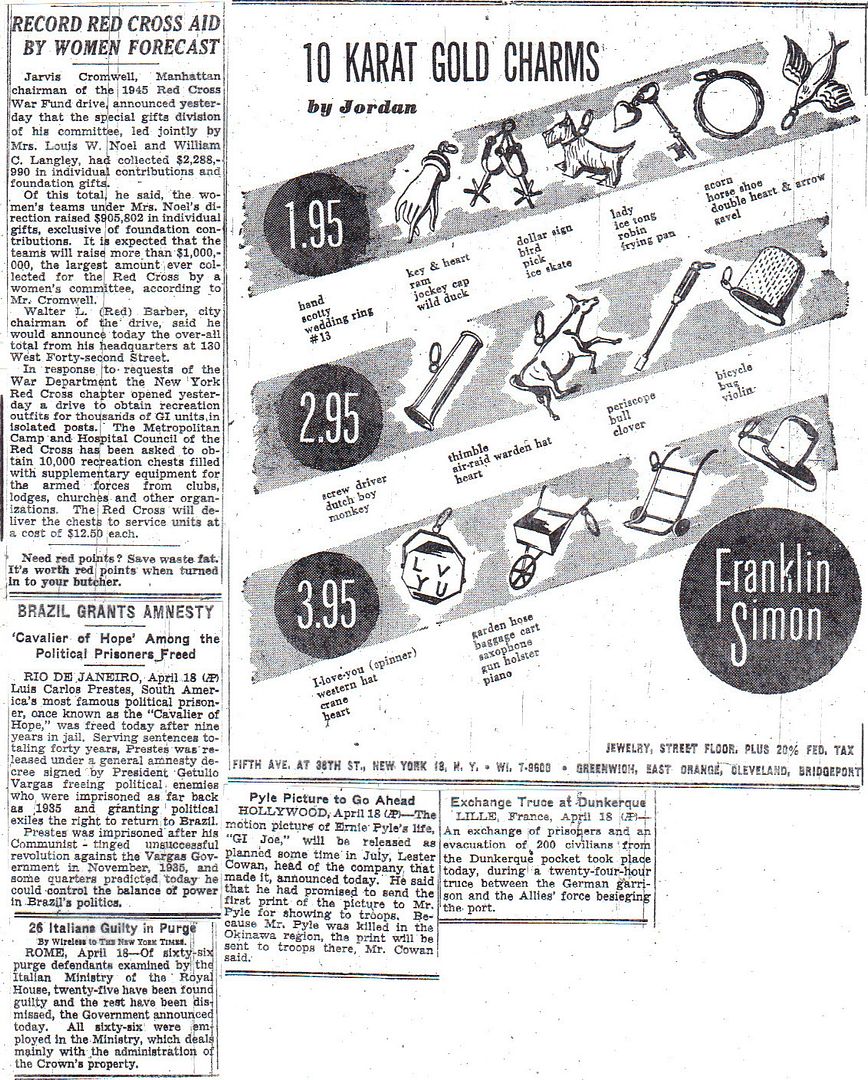

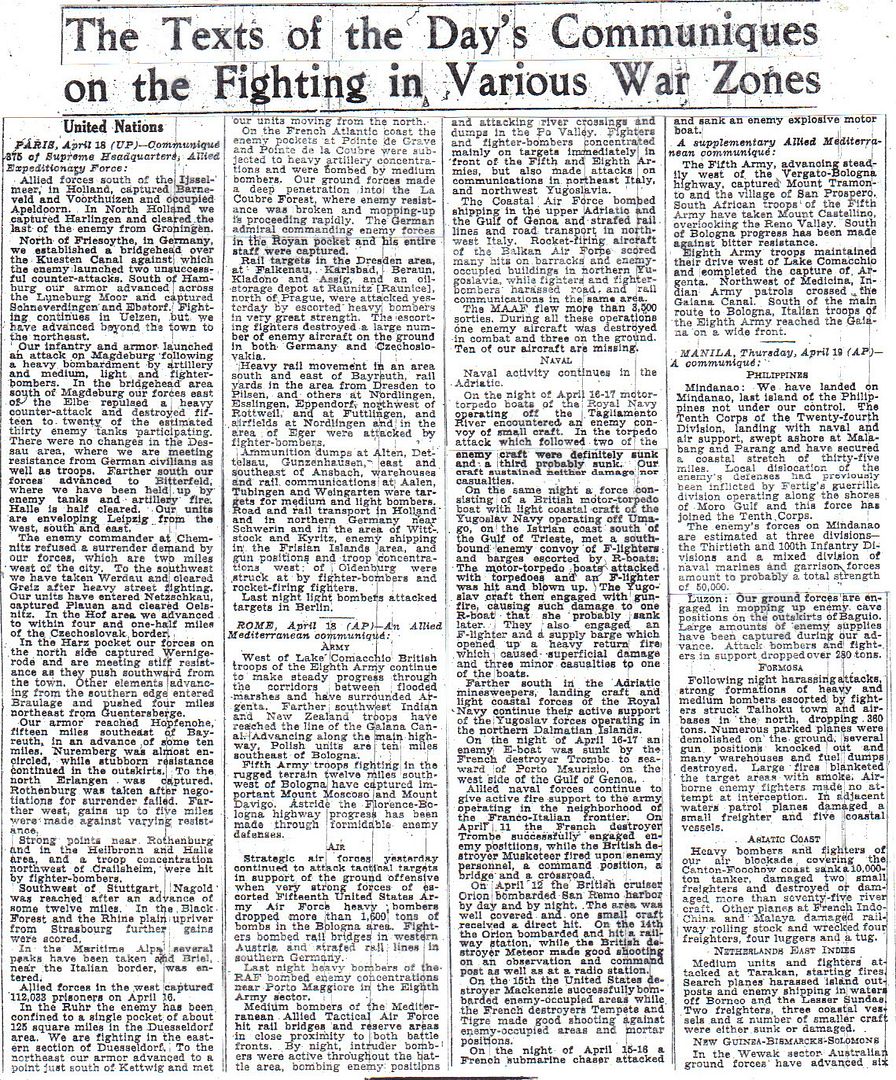
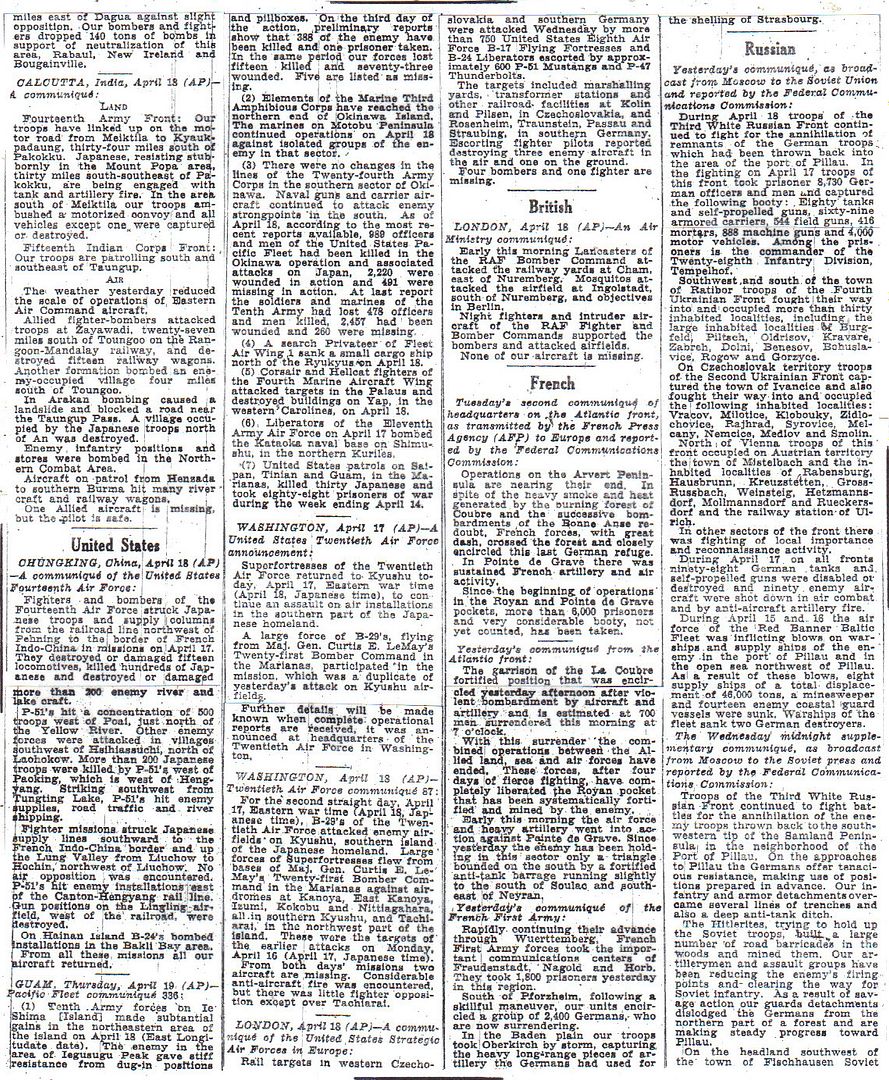
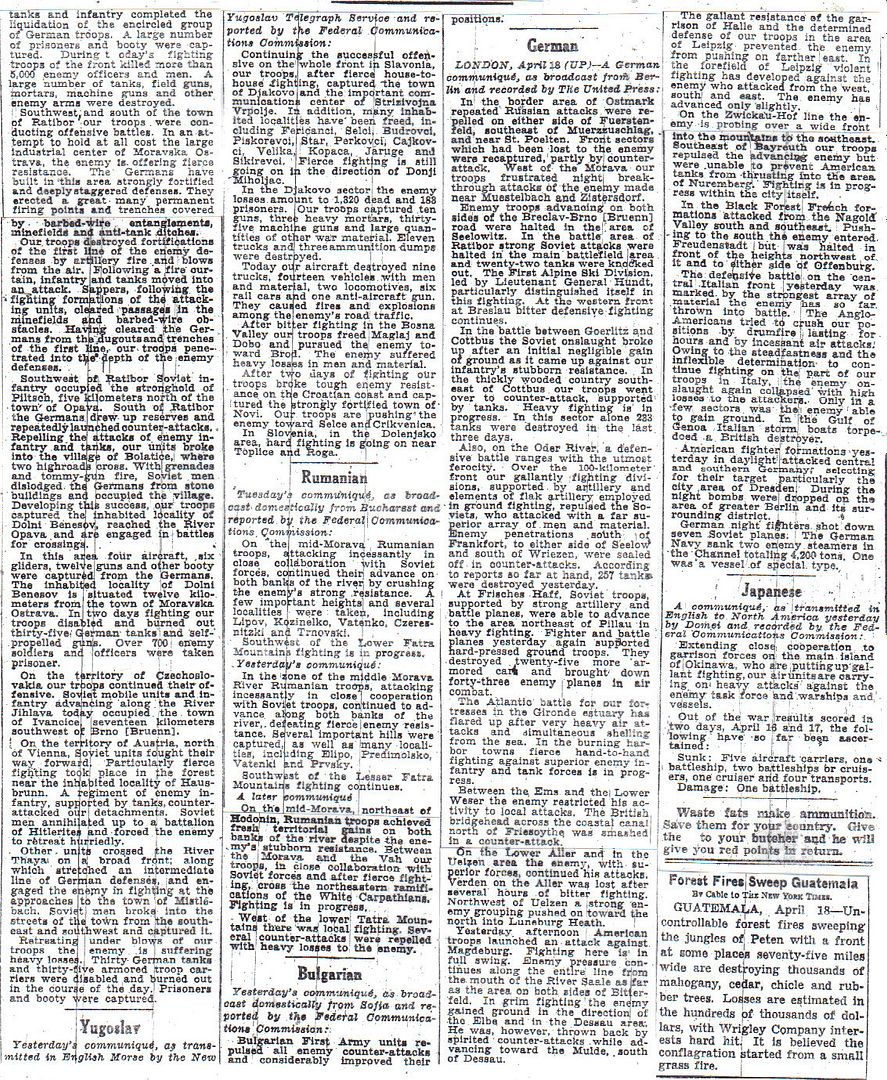
http://www.etherit.co.uk/month/3/19.htm
April 19th, 1945 (THURSDAY)
GERMANY: In the west, the U.S. First Army nears its final stop line in central Germany as it captures Leipzig and Halle. Eisenhower has ordered the First and Ninth Armies to halt along the Elbe and Mulde rivers and let the Red Army overrun areas that will be part of the post-war Soviet occupation zone. Leipzig is taken.
In the east, Zhukov’s army crashes through German defences and swarms to within 20 miles (32 km) of Berlin’s eastern suburbs.
Konev’s army threatens southern Berlin.
The British 2nd Army reaches the Elbe River south of Namburg.
German Field Marshall Model commits suicide.
Patton’s US forces cross the Czech border.
Final German surrenders in the Ruhr pocket total 325,000.
The Eighth Air Force flies Mission 961: 605 B-17s and 584 P-51s are dispatched to make visual attacks on rail targets in south-eastern Germany and north-western Czechoslovakia; they claim 18-1-5 Luftwaffe aircraft; 5 B-17s and 2 P-51s are lost:
- 135 B-17s bomb the Elsterwerda marshalling yards while 143 bomb the Falkenberg marshalling yards. Escorting are 191 P-51s that claim 5-0-0 aircraft; 1 P-51 is lost.
- Of 321 B-17s dispatched, 115 hit the railroad industry and rail bridge at Pirna while 87 hit Karlsbad and 109 bomb the marshalling yard at Aussig; they claim 6-1-2 aircraft; 5 B-17s are lost. The escort is 197 P-51s; they claim 7-0-3 aircraft.
Ninth Air Force bombers hit marshalling yards at Ulm, Neu Ulm, and Gunzburg (primary targets), the city of Donauworth and a target of opportunity at Schelklingen; weather prevents 70+ of the 450+ dispatched aircraft from bombing targets; fighters fly escort to the bombers, carry out patrols and armed reconnaissance, bomb a radio station, and cooperate with the US VII Corps in the Halle-Dessau area, the XII Corps attacking southeast from south of Bayreuth, the XX Corps in the Bamberg-Nurnberg area, preparing to drive toward Austria, and the XIX Corps along the Elbe River in the Magdeburg area.
Fifteenth Air Force heavy bombers Bischofshofen and Rosenheim while 78 P-38s dive-bomb the marshalling yard at Weilheim.
AUSTRIA: Fifteenth Air Force B-17s and B-24s bomb the Rattenberg railroad bridge and marshalling yards at Lienz, Klagenfurt and Linz.
CZECHOSLOVAKIA: Eighth Air Force fighter pilots shoot down five Me 262 jet fighters between 1150 and 1300 hours local.
NORWAY: During the night of 19/20 April, 11 Eighth Air Force B-24s fly CARPETBAGGER missions; 2 B-24s are lost.
ITALY: The US Fifth Army breaks out of the Apennines onto the Po plateau.
During the night of 18/19 April, Twelfth Air Force A-20s and A-26 Invaders bomb roads, vehicles, and lights in the Bologna, Turin, Milan, and Mantua areas, and continuing to attack Po River crossings, hit 8 bridges; B-25s and B-26s bomb bridges in the Brenner Pass and support ground forces at several points including Budrio, Vignola, and San Martino in the Soverzano areas; fighter-bombers hit dumps, communications, and close support targets in the US Fifth Army battle areas south and west of Bologna.
Fifteenth Air Force bombers attack the Avisio viaduct, the Vipiteno railroad bridge, Anti-Aircraft batteries near Grisolera and Santo Stino di Livenza, and several minor targets of opportunity.
CHINA: 12 Fourteenth Air Force B-24s bomb railway repair shops at Taiyuan; 3 others attack targets of opportunity in Bakli Bay on Hainan Island, 8 B-25s attack bridges and rail and road traffic north and northeast of Anyang and northeast of Taiku, damaging or destroying several locomotives and numerous boxcars; 100+ P-40s, P-51s, and P-47s attack town areas, troops, river, road, and rail traffic, and general targets of opportunity all over southern and eastern China and hit a few targets of opportunity in northern French Indochina.
BURMA: Pyinmana in the Sittang Valley falls to the 5th Indian Division.
XXXIII Corps clears the Mt. Popo area.
Magwe falls to the British 20th Indian Division.
14 Tenth Air Force P-38s hit supplies near Paklu, a fuel dump at Hainang, and bridges near Kunna; 1 bridge is knocked out; 6 other P-38s attack targets of opportunity along roads behind enemy lines; air supply operations continue as 800 tons of supplies are landed or dropped in forward areas.
COMMONWEALTH OF THE PHILIPPINES: US I Corps takes Vigan, Luzon.
Numerous missions are flown by the Far East Air Forces A-20s, B-24s and B-25s in support of ground forces on Luzon, Cebu, and Negros Islands. On Mindanao Island, Thirteenth Air Force B-24s bomb personnel areas at Kabacan, Cagayan, and along the Davao River. USMC SBD Dauntlesses attack IJA positions on Jolo Island. B-25s and USMC F4U Corsairs and SBDs sweep highways and road on Mindanao.
FORMOSA: Fifth Air Force B-24s bomb Tainan Airfield and Shinchiku town.
JAPAN: While serving as a radio operator on board a B-29 Superfortress over Koriyama, Henry Eugene “Red” Erwin, of Leeds, Alabama, was responsible for dropping phosphorus smoke bombs. One of the bombs exploded in the launching chute. The burning phosphorus bomb shot back into the interior of the aircraft, striking him in the face and obliterating his nose and completely blinding him.
Erwin realised that the aircraft and crew would be lost if the burning bomb remained in the plane. He picked it up and instinctively crawled toward the co-pilot’s window. Erwin located the window and threw the bomb out. Engulfed in flames, he fell back upon the floor.
The smoke cleared and the pilot pulled the plane out of its dive at 300 feet. Erwin’s gallantry and heroism went above and beyond the call of duty and saved the lives of his comrades, according to the citation for his subsequent Medal of Honor. (MOH) (Air Force Print News)
The Seventh Air Force flies Very Long Range Mission 4:
104 P-51s based on Iwo Jima fly a fighter sweep to Atsugi and Yokusuka Airfields; they claim 23-0-7 aircraft in the air and 14-0-23 on the ground; 2 P-51s are lost.
Eight Eleventh Air Force B-25s off to bomb Kurile Island targets abort due to weather.
Iva Toguri, a Japanese-American marries Felipe D’Aquino, a Portuguese, registering with the Portuguese consulate in Tokyo and Toguri declining to take her husband’s citizenship.
OKINAWA: An enormous bombardment precedes attacks on the Shuri Line, but the 7th, 27th and 96th Infantry Divisions make small gains and suffer severe losses. The 1st and 6th Marine divisions complete occupation of north and central Okinawa.
PACIFIC OCEAN: US submarines sink 9 Japanese vessels at sea:
- Submarine USS Cero (SS-225) sinks a guardboat south of Japan.
- Submarine USS Sennet (SS-408), attacking a convoy in Kii Suido
off the south coast of Kyushu, sinks an auxiliary submarine chaser and a merchant cargo ship.
- Submarine USS Silversides (SS-236) sinks a guardboat .
- Submarine USS Sunfish (SS-281) attacks a convoy off Hokkaido, sinking a gunboat and a merchant cargo.
- Submarine USS Trutta (SS-421) sinks a merchant vessel and two merchant fishing boats.
PALAU ISLANDS: 25 Seventh Air Force B-24s, based in the Palau islands, bomb nearby Arakabesan and Koror Islands.
BONIN ISLANDS: 8 Seventh Air Force P-51s from Iwo Jima bomb and strafe Futamiko in the Bonin Islands. During the night of 19/20 April, 6 P-61 Black Widows from Iwo Jima, operating singly and at intervals, bomb and strafe Chichi, Haha, and Muko Jima Islands.
BORNEO: Thirteenth Air Force B-25s attack Tarakan while B-24s bomb Sandakan.
CAROLINE ISLANDS: 17 Seventh Air Force B-24s from Guam bomb Dublon, Fefan and Eten Islands in Truk Atoll.
U.S.A.: The musical “Carousel”, based on Molnarís “Liliom,” opens at the Majestic Theatre in New York City. John Raitt and Jan Clayton starred in the show which ran for 890 performances. Music was by the team of Richard Rodgers and Oscar Hammerstein.
Top right on page 6, the liberation of the “legless ace.” I remember when he died, in the 1980s iirc. My mother’s property manager, a former RAF pilot, told us about him.
$500 says he doesn't make it past the end of the month.
Douglas Bader got a bit of coverage on these threads back in 1940 during the Battle of Britain. He was a bit of a thorn in Marshal Dowding's side. I posted excerpts from "With Wings Like Eagles: The Untold Story of the Battle of Britain," by Michael Korda. It is a good account of the BoB.
I remember. I wonder if my library has the book ... brb.
Yep. I remember, now, reading his bio of Lawrence of Arabia.
Two hundred and forty years ago today:
On April 19, 1775, British and American soldiers exchanged fire in the Massachusetts towns of Lexington and Concord. On the night of April 18, the royal governor of Massachusetts, General Thomas Gage, commanded by King George III to suppress the rebellious Americans, had ordered 700 British soldiers, under Lieutenant Colonel Francis Smith and Marine Major John Pitcairn, to seize the colonists’ military stores in Concord, some 20 miles west of Boston.
A system of signals and word-of-mouth communication set up by the colonists was effective in forewarning American volunteer militia men of the approach of the British troops. Henry Wadsworth Longfellow’s poem “Paul Revere’s Ride” tells how a lantern was displayed in the steeple of Christ Church on the night of April 18, 1775, as a signal to Paul Revere and others.
One if by land, and two if by sea;
And I on the opposite shore will be,
Ready to ride and spread the alarm
Through every Middlesex, village and farm,
For the country folk to be up and to arm.
At Lexington Green, the British were met by approximately seventy American Minute Men led by John Parker. At the North Bridge in Concord, the British were confronted again, this time by 300 to 400 armed colonists, and were forced to march back to Boston with the Americans firing on them all the way. By the end of the day, the colonists were singing “Yankee Doodle” and the American Revolution had begun.
I'll have to go back to my older news reports. As I recall, Gene Currivan wrote the first hand report and Drew Middleton provided the big picture from HQ. Hanson W. Baldwin followed up with an analysis.
:-)
WW2: Near Halberstadt/Gerode, Germany, April 19-20, 1945
https://www.youtube.com/watch?v=Q9TT77i1mPU
http://running50.com/april-19th-1945-seeking-the-truth-about-war/
At dawn on morning of April 19th, 1945, my grandfather’s tank battalion was part of a disastrous attack on the first of three Japanese strongholds — Kakazu Ridge. My grandfather was assigned to the 193rd Tank Battalion, which was attached to the 27th Infantry Division. A former New York National Guard unit consisting of just over 16,000 troops, the 27th was put into “floating reserve,” and its primary role in the campaign would be to serve as an occupation garrison once the fighting was over. “In retrospect,” writes one author, the 27th appears to have been a “jinxed outfit.” It was held in low regard at the time not only because of its low numbers, perceived lack of training, and inexperienced officers, but also because it fought poorly at Makin and failed again on Saipan, where its commanders were accused of excessive caution and lack of aggression. “Soldiers moved slowly to keep casualty lists short,” writes author and Marine veteran William Manchester. “Marine’s lunged at the enemy, sometimes at reckless speed, because they knew that until the fighting ended the fleet which had landed them would be vulnerable to enemy attack.”
The plans originally set out by American commanders changed abruptly after it became clear that the Japanese defenders would need to be rooted out — or sealed off — hole by bloody hole. The 27th was pulled from floating reserve and landed on the island April 9th. By the 18th, the 27th joined two other Army infantry divisions — the 96th and the 7th — in an assault of Kakazu Ridge. According to the official history of the 27th, the heavily-defended Kakazu Ridge “stretched two thousand yards across the front and rose two hundred feet in the air. In its near sides were Japanese-occupied pillboxes and about halfway from the cut where Route 1 passed through it and Kakazu Village was a high tower of rock, later to become known as The Pinnacle.” The ridge was of supreme military importance because from that ridge Japanese forces could direct fire on all terrain held by American forces. “As long as the ridge was in enemy hands,” the official history continues, “he could observe troop movement along Route 1, shell CPs and other installations, and make Buzz Bomb Bowl a no-man’s-land by bringing down murderous fire on any movement.”
By this time in the war, American commanders had figured out a two-step process to efficiently and effectively attack and destroy fortified Japanese positions. Step one: “Guns and howitzers battered Japanese cave openings, dugouts, and pill-boxes,” wrote the official Army historians, “forcing enemy gunners back into tunnels for protection and decreasing their fields of fire.” Step two: “Taking advantage of the resulting ‘dead space,’” the historians continue, “infantry and tanks crept up on the most exposed point; the tanks attacked the position point-blank with cannon, machine guns, and flame, while the infantry prevented Japanese ‘close-quarters attack troops’ carrying explosives from closing in on the tanks.”
The “tank-infantry team”, as it was termed, waged the battle, but in the end it was frequently flame and demolition that destroyed the Japanese in their strong-holds. With an apt sense for metaphor, Lieutenant General Simon Bolivar Buckner, Jr., the commander of the 10th Army on Okinawa, called this the “blowtorch and corkscrew” method. Liquid flame was the blowtorch; explosives, the corkscrew.
“The idea that there are rules in warfare,” writes author Sebastian Junger, “and that combatants kill each other according to basic concepts of fairness probably ended for good with the machine gun. A man with a machine gun can conceivably hold off a whole battalion, at least for a while, which changes the whole equation of what it means to be brave in battle.” Indeed, the military tactics employed during the Battle of Okinawa were geared toward maneuvering the enemy into a position where they could, essentially, be massacred from a position of safety.
“It sounds dishonorable,” continues Junger, “only if you imagine that modern war is about honor; it’s not. It’s about winning, which means killing the enemy on the most unequal terms possible.”
*****
Like clockwork, the new offensive of April 19th began with a barrage of 324 artillery guns, ranging from 105-mm cannon to huge 8-inch howitzers, which were joined by battleships, cruisers, and destroyers. This barrage was followed by napalm, rockets, and bombs that were dropped by 650 Navy and Marine planes. The defenders of the ridge, however, were one step ahead of the American commanders. Instead of playing into the American commanders’ hand, the Japanese waited patiently in relative safety for the artillery barrage and aerial attack to end. They knew to dig in on the reverse slope of the ridge, which shielded them from the most intense fire. Once the firing ceased, they emerged from their caves and rained mortar rounds and grenades upon the infantry troops advancing up the forward slope. Brigadier General Josef Sheetz, who commanded the American artillery, later expressed doubt that his guns had killed even one enemy soldier for every 100 rounds of the 19,000 that were fired that morning.
As the 27th prepared for step two, it became clear to commanders that their tanks would not be able to attack up Kakazu Ridge with the infantry — a yawning gorge in front of the ridge made it impossible for the tanks and infantry to assault together, the way they had been trained. According to one author, “The gorge formed a gigantic natural tank trap that no tracked vehicle could cross.” While the commanders would have ideally paired tank teams with infantry and support them both with artillery, it was decided that Company A of the 193rd — my grandfather’s company — would drive around the western end of Kakazu Ridge and enter Kakazu Village, where it would then link up with the infantry companies that were tasked with attacking and overrunning the ridge itself.
“About the only instance I know of where tanks tried to operate without riflemen in the Pacific,” wrote author and Marine veteran Eugene Sledge, “was a case of army tanks in Okinawa. Predictably, the Japanese knocked out most of those tanks. Marine tanks always operated with riflemen, like a dog with his fleas.”
At 7:40 AM, 30 Army tanks — including one driven by my grandfather — and 105-mm M7 self-propelled howitzers started out in groups of three and four in column formation, supported by the 27th Infantry Division. An intense artillery and mortar barrage courtesy of the Japanese 272nd Independent Infantry Battalion soon halted the advancing infantry. Undaunted, the unsupported tanks pushed on, losing three tanks to mines and road hazards almost immediately.
Soon thereafter, the tanks — now isolated and exposed — stumbled into an ambush set by the Japanese 22nd Independent Antitank Gun Battalion. Lost in a maze of unmapped roads and trails, the leading tanks missed their turnoff and began to take fire from 47-mm antitank guns concealed to the left of the trail, on the edge of Nishibaru Ridge. Four tanks were quickly destroyed with 16 shots. “We could hear the radio messages from the tanks,” remembers one officer. “It was heartrending to listen to their agonized pleas for assistance as they became cut off, isolated, and under constant attack.”
Before Okinawa, the Sherman tank had operated with near impunity throughout the Pacific. It’s armor, however, was no match for the Japanese 47-mm antitank guns used on Okinawa. They could make a Sherman look like what one author described as a “hunk of Swiss cheese.” The crews operating these tanks — many of whom were fresh out of boot camp — quickly came to realize that being killed or maimed at any moment was as much a part of life as breathing.
The remaining tanks then scurried down the road, looking for a faint track that was to lead them into Kakazu Village. The tanks, guided by company commander Captain Harry R. McAmick, missed the track, lost another tank to antitank fire, and then in error took a trail further south. They then began, according to one historian, “working over enemy positions encountered…in the relatively flat country to the east of Kakazu.” It wasn’t long thereafter that Captain McAmick began to realize that the road they were on would not get them to Kakazu Village. To correct his mistake, he retraced his steps back to the main route and moved north toward the American lines. Within minutes, he found the trail they were originally looking for and led his vehicles down into Kakazu Village, arriving shortly after 10:00 AM.
For over three hours, the tanks roamed back and forth through the village, basting enemy fortifications and gun emplacements. As the official history of the 27th Infantry Division notes, from shortly after 10:00 AM until 1:30 PM, “Captain McAmick’s tanks occupied the village, moving up and down the streets and blasting everything in sight while waiting for the infantry units to come over the ridge and join them. In this absolutely unsupported tank action, the whole village of Kakazu was utterly destroyed and the remnants of Japanese forces were either killed or fled.”
At the same time, however, the Japanese were preparing to counter the American advancement. Attacking with “mines, 47-mm Model 1 antitank guns, artillery, and suicide squads,” the Japanese wreaked havoc upon the unsupported tanks. “Suicide squads first blinded the tank crews with hand-thrown Model 94 smoke candles,” wrote historian Gordon L. Rottman, “kept them buttoned up with Model 97 grenades and small-arms fire, and flung 22-pound satchel charges beneath the tanks. Hand-placed magnetic demolition charges were also used — their one and a half pounds of TNT could penetrate a Sherman tank’s side and top armor.”
Once a tank was disabled, the Japanese “swarmed over [them]…forcing the hatches open and grenading the crews.” All told, 14 tanks were destroyed or disabled in and around Kakazu Village.
None of the resources I’ve consulted report how many casualties the 193rd took that morning. The Operations Report only lists the number of casualties for the entire battle: 7 officers (2 killed in action) and 56 enlisted men (18 killed in action). “The proportion of men killed or seriously wounded to those slightly wounded was much greater than commonly found in foot troops,” writes Lt. Col. John L. Behrns, the commander of the 193rd. “Only two (2) cases of battle fatigue occurred,” he adds, which seems low considering the fact that there were 26,221 reported cases of “neuropsychiatric, ‘non-battle’ casualties” during the three months American forces fought on Okinawa — more than in any previous battle in the Pacific Theater.
In the meantime, the rifle companies of the 27th that were assaulting Kakazu Ridge were being repelled by heavy resistance. As the official history of the 27th notes, “Every man who attempted to get over the ridge and into Kakazu was shot down or drew several mortar shells.” By late afternoon, the infantry still had not reached the crest of the ridge.
At around 1:30 PM, once it became clear to commanders that the infantry was not going to be able to reconnect with the tanks, the surviving tank crews received orders to return to the American lines. “Of the thirty tanks that had maneuvered around the left end of Kakazu Ridge in the morning,” wrote Army historians, “only eight returned in the afternoon.”
The loss of 22 tanks on April 19th, 1945, was the greatest suffered by American armor during the entire Pacific War.
Five days later, the Japanese commander in charge of those dug into Kakazu Ridge realized that their position had become untenable. Under cover of darkness, the Japanese forces relinquished their positions as part of an orderly withdrawal to their next main system of defensive fortifications — the Naha-Shuri-Yonabaru Line. While indisputably an American victory, the battle for Kakazu Ridge took a heavy toll on American forces, many of whom were only then beginning to realize how hard they would have to fight for every bloody inch of that island.
-----
The Execution of General Charles Delestraint

On April 19, 1945, just 10 days before the Dachau concentration camp was liberated by the US Seventh Army, General Charles Delestraint was allegedly executed at Dachau and his body was immediately burned in the crematorium. Once the acknowledged leader of the French political prisoners at Dachau, General Delestraint has long since faded into obscurity and the reason for his untimely death at Dachau remains a mystery. There are several unofficial reports, written by the survivors of Dachau, which describe the events on the day of his alleged execution, but no two agree.
http://www.scrapbookpages.com/DachauScrapbook/GeneralDelestraint.html

Harry Truman on April 19, 1945
CREDIT: Harry Truman, half-length portrait, seated at desk, facing front, holding pencil, ca.1945. Prints and Photographs Division, Library of Congress. Reproduction Number LC-USZ62-70080.
-----
He looks to me to be energized by the new job.

Liberated inmates at the first memorial service for the dead of Buchenwald Concentration Camp. In the background is the temporary monument to the dead, April 19, 1945. Photo: Donald R. Ornitz, U.S. Signal Corps. National Archives Washington
19 April 1945 At a memorial service for the victims of Buchenwald Concentration Camp, a survivors’ pledge is read out: the Oath of Buchenwald: “We will take up the fight until the last culprit stands before the judges of the people. Our watchword is the destruction of Nazism from its roots. Our goal is to build a new world of peace and freedom.” More than 400 inmates have died since the camp’s liberation.
Disclaimer: Opinions posted on Free Republic are those of the individual posters and do not necessarily represent the opinion of Free Republic or its management. All materials posted herein are protected by copyright law and the exemption for fair use of copyrighted works.